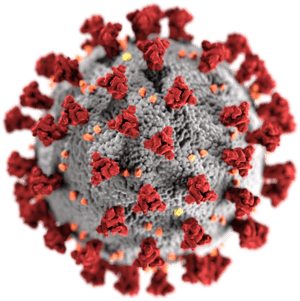Peplomer facts for kids

Imagine a tiny, tiny virus. On its outside, it has little spikes! These spikes are called peplomers. They are made of a special kind of protein and sugar, called a glycoprotein. Think of them like keys on the virus's surface. These "keys" help the virus unlock and enter a cell.
When a virus wants to get inside a cell, its peplomers try to connect with specific "locks" on the cell's surface. These "locks" are called receptors. A virus can only attach to cells that have the right "locks" for its "keys." This is why some viruses only infect certain types of cells or certain animals.
Peplomers are super important! They decide which cells a virus can attack. They also play a big role in how easily a virus can spread and cause an infection.
Contents
What Are Peplomers?
Peplomers are like tiny antennas or spikes found on the outer layer of a virus. This outer layer is often called the capsid. These spikes are not just for show; they have a very important job. They are made of a mix of protein and sugar molecules, which is why they are called glycoproteins.
How Peplomers Help Viruses
Peplomers are essential for a virus to start an infection. Here's how they work:
- Finding the Right Cell: Each type of virus has peplomers shaped in a specific way. This shape allows them to recognize and attach to certain "receptor" molecules on the surface of a cell. Think of it like a puzzle piece fitting perfectly into another.
- Entering the Cell: Once the peplomer connects with the cell's receptor, it helps the virus get inside the cell. This process is called viral entry. Without the right peplomers, a virus cannot enter a cell and cause an infection.
- Spreading Infection: The way peplomers attach to cells also affects how easily a virus can spread from one person or animal to another. Viruses with peplomers that attach very well can be highly infectious.
Examples of Peplomers
A well-known example of peplomers is the "spike protein" of the SARS-CoV-2 virus. This is the virus that causes COVID-19. The spike protein is a peplomer that helps the virus attach to human cells and enter them. Scientists study these peplomers to understand how viruses work and to develop medicines or vaccines.
Related Topics
- Viral entry: Learn more about how viruses get inside cells.
Images for kids
-
Coronavirus spike proteins (turquoise) projecting from the surface of SARS-CoV-2, the virus that causes COVID-19. The protein is glycosylated and its glycans are shown in orange.
-
3D print of one of the trimeric spikes of SARS-CoV-2
See also
 In Spanish: Espícula viral para niños
In Spanish: Espícula viral para niños




